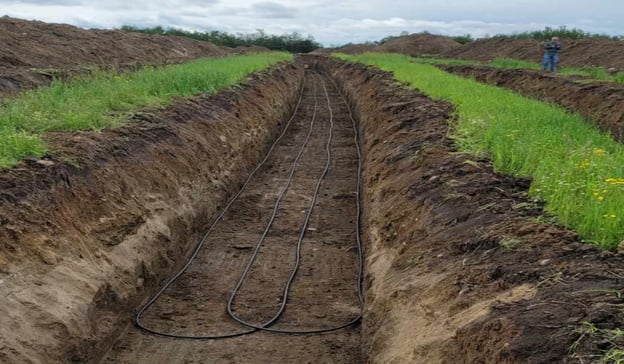Easily be greener, heat and cool in rural Alberta with horizontal loops

In areas where population density is low, homeowners and businesses tend to have more land. People are spread out. Towns and communities can still be considered “rural” when they are small, and farther away from urban centers. Still, homes and businesses take advantage of the low density with larger lots and more acreage. That’s what makes rural Alberta perfect for highly efficient,ecologically sound Ground Source Heat Pumps (GSHPs).
Is a Geothermal system right for your home?
Ground Source Heat Pumps use the relatively constant temperatures underground as heat source or heat sink in a heating and cooling system. Pipes that carry an antifreeze fluid are buried under the ground. The fluid remains in the closed loop piping, and is circulated via a pump either bringing heat energy out of the ground in the winter, or pushing the summer heat underground, cooling the interior of a home or business.
Where to put the pipes?
GSHP piping can be buried in a few different ways. One way calls for the pipe loop to be buried in a hole that goes straight down approximately 200 feet. While this option takes less space, it has its own challenges, including finding someone to drill the hole, Labor shortage of drillers in Canada. When the land is available, the next option, a horizontal loop system is preferred.
A horizontal loop system calls for the piping, usually made of a high-density polyethylene plastic, to be buried in a trench that is 6-8 feet deep. These trenches can be up to 300 feet long, but alternately wider trenches will allow the length of the trench to be shorter. If there is a body of water nearby, such as a pond or a lake, the piping is often coiled on the bottom, where the water temperature closely mirrors the constant temperature of the ground at that depth.
Once the piping is buried, they stay there, undisturbed for as long as the system is in use. The fluid inside will stay inside the piping (as long as the pipes are not punctured). They require no maintenance. Most traditional heating and cooling systems are expected to last around 15 years. A GSHP piping system is expected to last 50 years, maybe even longer.
Ground Source Heat Pumps do not use fossil fuels to heat or cool a home or business. The combined heating and cooling equipment will often use less electricity than standard heating and cooling systems, and require less maintenance and lower operating costs. When comparing systems that use natural gas, fuel oil or just electricity, a GSHP is more ecologically friendly, even when the electricity used comes from non-renewable sources.
For rural Alberta, where the population density is lower, and the space is available, a Ground Source Heat Pump using horizontally laid underground loops can be the perfect solution for economical, cleaner heating and cooling.
Now is the time to start a new geothermal project and “get your loops in!” We can guide your application and help you apply for incentive programs too. Envirotech Geothermal proudly serves the rural areas of Lakeland, Parkland, Strathcona, Leduc, Red Deer, Wood Buffalo, Lac La Biche, Barrhead and other Alberta Municipalities to discover the benefits and features of geothermal heating and cooling. Contact us today to learn how you can save up to 70% on your heating cooling bills by utilizing geothermal heating and cooling in your home. Call us at 780.717.3605 or request a Geothermal Consultation for more information.
